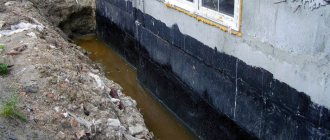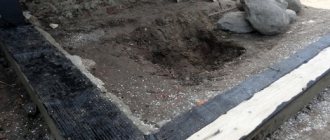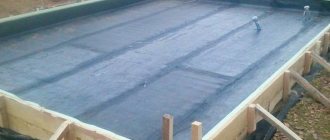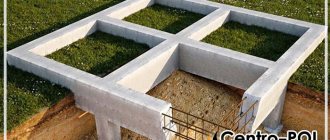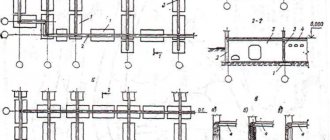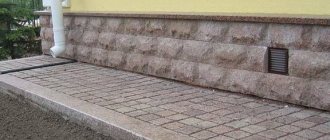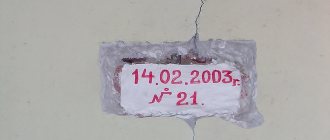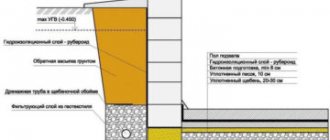What is foundation waterproofing?
Foundation waterproofing
is a set of works aimed at isolating the concrete foundation of a house from water and moisture. Such work is carried out immediately after the construction of the foundation, before the construction of walls begins.
The fact is that concrete, due to its porous microstructure, is like a sponge. It very quickly and easily absorbs moisture from the atmosphere and soil. This is bad for 3 reasons.
- The microclimate in the basement deteriorates, mold and mildew (sometimes very dangerous types) appear, which can penetrate into living spaces.
- The strength of the foundation is compromised. This affects the overall strength of the house and its longevity.
- Without waterproofing, moisture from the foundation can seep into your home, leaving your floors and lower walls always damp. This can also cause the development of fungus.
It will be surprising to many that water can reduce the strength of concrete, but it is true. How? Just imagine that the reinforced concrete structure of the foundation, not protected in any way from the penetration of water, absorbed moisture from the soil waters after the autumn rains. And suddenly, after a couple of days, frost hit. Naturally, the water will freeze inside the foundation, and as you know, when it turns into a solid form, it tends to expand. So it turns out that ice destroys concrete from the inside. And sometimes frosts alternate with thaws, and in one season a reinforced concrete structure can seriously lose its strength.
Every year the situation will only get worse - cracks will appear, the foundation will sag in places and will need to be strengthened, and the walls will sag along with it. So timely waterproofing can save you a significant amount. Therefore, at the initial stage of drawing up an estimate for building a house, be sure to include the costs of materials and work on waterproofing the foundation.
Consequences of lack of foundation waterproofing
When is waterproofing necessary?
Foundation waterproofing
necessary to ensure the safety and durability of homes. Especially if you plan to equip a living or utility room on the ground floor. It is imperative to take care to protect the foundation from moisture, and as a result, mold formation and destruction.
Of course, each case should be considered in particular. Much depends on the brand of concrete and additives in it. Thus, some brands have special waterproofing additives that make foundation insulation work unnecessary.
It is important to consider the climate in your region: whether it rains frequently or whether dry weather prevails. Rainwater, like melting snow, affecting the foundation year after year, can destroy it and lead to the formation of cracks in the walls.
Accumulating under the foundation and penetrating the capillaries of building materials, water can rise up the walls to a height of about 10 meters, creating a pressure of up to 1.5 tons/1m².
It is also worth paying attention to the height of the groundwater. If groundwater comes close to the surface, then construction of a house cannot be continued without insulation. But if the soil remains dry even at depth, you can do without the hassle of creating waterproofing for the foundation.
Note! Do not confuse soil water with groundwater. Soil water is everywhere, which is why the soil is always wet. But groundwater can lie at different depths, it all depends on the location of the water-resistant layers, as well as the topography. At higher elevations, groundwater lies deep, while in lowlands it is closer to the surface.
If you live in the middle zone, and not somewhere in Africa, and the foundation is made of the most ordinary concrete, then you cannot do without waterproofing work. Otherwise, you risk your health and the health of your loved ones living with you.
Tape
The strip foundation is the most common and has two varieties: shallow and recessed.
The non-buried version of this foundation is used on stable soils with low groundwater levels. If the grade of concrete in a strip foundation is M250 or higher, then if there is an insulated blind area with water drainage, there is no great need for vertical protection of the foundation, although it will still be useful. Horizontal waterproofing is required.
The use of a buried foundation strip is justified only if a basement is required. This type of foundation necessarily needs full protection from all sides.
Additional protection from water is not required if the foundation construction technology uses permanent formwork made of dense polystyrene foam, which does not allow water to pass through. Although waterproofing and polystyrene foam are often used together, as in the photo below.
If the foundation is made of FBS blocks, where there are seams between the blocks, waterproofing is required.
How to protect concrete from moisture?
There are 2 ways to protect concrete structures from the destructive effects of water:
- Adding special additives to concrete when pouring the foundation, which reduce its natural hygroscopicity. We have already mentioned it.
- Creation of an additional hydrophobic layer over the entire surface of the foundation, which is exposed to moisture. To do this, you can use mastic, special powder or insulating materials in the form of rolls or sheets.
The first option is very labor-intensive. You will need a concrete mixture that does not absorb moisture. And since you can’t make it yourself, you need to find a manufacturer or supplier. It’s good if you live in a large city or very close to it, in which case there is a high probability of finding what you need. But if you live somewhere outside the periphery, then problems may arise with finding such concrete mixtures.
For this reason, it is the second waterproofing option that is the most common. It is simple, reliable, and does not require special equipment or special skills. You can carry out such work yourself if you do not want to spend extra money on the services of specialists.
Creating a hydrophobic layer on the surface of the foundation
Types of foundation waterproofing
The principle of isolating a foundation monolith according to the second option has 2 types: vertical and horizontal. Let's look at each of them in detail.
Vertical foundation waterproofing
According to this principle, the entire vertical surface is insulated, regardless of the type of structure (monolithic slab, strip or pillars). This allows you to protect the reinforced concrete structure from the effects of groundwater and rainwater. Vertical insulation is applied from the outside of the foundation or from the inside, depending on the technology you choose. Types of vertical waterproofing:
- coating;
- pasting (film or roll);
- penetrating;
- screen
Coating waterproofing
Coating waterproofing
not only protects the house from moisture, but also helps to retain heat during the cold season. At the first stage, it is necessary to round the corners of the foundation and create a fiberglass reinforcing mesh. On this base, mastic or a mixture of bitumen-rubber or bitumen-polymer should be applied sequentially, in several layers. This can be done with a regular brush for painting walls. The main condition for reliable protection from moisture is that the material must fit very tightly to the foundation. You should not use ordinary bitumen for these purposes, as it will quickly begin to deteriorate. This method of foundation waterproofing is very popular among those who build a house with their own hands, as it is suitable for absolutely any foundation, and the materials can be bought at any hardware store; they are inexpensive.
But there are also obvious disadvantages to this method. It will not protect the foundation from erosion by groundwater, therefore it is not suitable for areas where their pressure is quite strong (only a specialist can judge this objectively). In addition, neither the mixture nor the mastic provide 100% protection from moisture. After about 10 years of use of the house, such insulation may begin to crack.
Pasted waterproofing of the foundation
Foundation gluing technology
film or roll material is universal. Did you immediately remember the notorious roofing felt? No, this material is no longer used for insulation. There are many modern materials on the building materials market that provide excellent sealing and are relatively inexpensive: stekloizol, steklomast, technoelast, hydrostekloizol (TPP3 / TPP3.5). If you choose this option, you will also need waterproof mastic for gluing the insulating material. Before starting pasting, you need to prepare the foundation: smooth out any unevenness, apply a primer and wait until it dries completely. In a few days you can begin the main work. It is better to measure the film/roll material in advance using a tape measure and cut it according to the required dimensions. For application, you can take a regular paint brush; it makes it easy to apply the mastic in an even layer.
Pasted insulation can be used even in areas with aggressive groundwater pressure. Even in such conditions, high-quality insulating materials will last at least 80 years.
The downside is that before starting work, some preparation will be required. This method will not suit you if the weather does not allow you to wait several days for the primer to dry.
Waterproofing membrane on the foundation of a house
Penetrating waterproofing
A completely different technology is used for penetrating waterproofing
. The name itself suggests that the insulating material penetrates the pores of the foundation, strengthening it not only from the outside, but also from the inside. You will need a special cement-quartz mixture with active additives. Before application, it should be diluted with water to the consistency of thick sour cream, and applied exclusively to a damp foundation (just wet it with water).
In order for the mixture to penetrate well into the pores of the foundation, it is enough to apply a layer up to 3 mm thick. At the same time, the penetration depth of the solution is up to 50 mm, which is quite sufficient for high-quality protection from moisture. It is better to apply the solution both from the outside and from the inside of the foundation. Thus, a kind of membrane is formed on the surface, and the rest of the solution will penetrate the pores of the concrete and seal them.
Moreover, the process of sealing and strengthening the foundation continues after completion of the work, without your participation. Each time it comes into contact with moisture, the waterproofing effect will increase.
But this barrel of honey was not without a drop of ointment. For example, if you decide to build from porous concrete (expanded clay concrete, foam concrete, etc.), penetrating waterproofing will not suit you. And finding a special mixture is not so easy. Probably due to its high cost, not all hardware stores buy it.
Screen waterproofing
Screen waterproofing
- a kind of “armor” for the foundation, which is created from bentonite mats or clay concrete slabs. Both of these materials excellently strengthen the structure, protect it from moisture and the effects of groundwater flows. Therefore, the service life of the foundation is significantly increased. The use of clay concrete slabs or mats can be combined with the previous three methods of waterproofing.
Mats for screen waterproofing are made of several layers: geotextile, composite material and bentonite (granules). The advantage of bentonite mats is that upon contact with moisture, bentonite granules swell, filling cracks and voids, and strengthening the foundation of the house. Some manufacturers also add a polyethylene geomembrane.
They must be overlapped, then they will provide a good seal. In turn, clay concrete slabs/panels should be installed “joint to joint”, well insulating the seams. Fastening to the foundation is done using dowels.
Without a doubt, this type of insulation is the most reliable and durable. But let's be objective, it does have flaws. Take, for example, the high cost of materials and labor. If you could easily do the previous types of foundation waterproofing yourself, then in this case you cannot do without craftsmen.
It is necessary to think over the configuration, select materials, and, of course, correctly install mats or slabs. This requires appropriate knowledge and professional tools.
Note!Screen insulation is used only for the outside of the foundation.
Screen waterproofing of the foundation
Horizontal waterproofing of the foundation
To fully protect the base, it is worthwhile to take care of waterproofing the horizontal surface of the structure over the entire area during the construction of the house. This helps protect the load-bearing walls of the building from capillary moisture, which will avoid dampness, mold and mildew inside the house.
This insulation is also called cut-off insulation. Don't neglect it, and you will save yourself from additional repair costs in the future.
Horizontal insulation is performed using various materials:
- roll (pasting);
- impregnating (penetrating).
Waterproofing the foundation with rolled materials
To protect concrete from moisture, it is necessary to make a screed from a solution of cement, sand and special additives. When the screed is completely dry, you can begin priming the floor using a primer (bitumen or water based).
This is followed by the application of polymer or bitumen mastic, onto which roofing felt (or other materials) can immediately be glued. If you purchased roll material with an adhesive layer, wait until the mastic dries and only then start gluing the insulation.
When choosing floating insulation, prepare a propane torch in advance, since the roll must be heated, and only then rolled out on the floor of the basement.
When purchasing materials, it is important to remember that adhesive insulation is performed in 2-3 layers. In this case, you need to lay the material so as to close all the joints.
Note! If the building does not have a basement, insulation is allowed only at the points of contact between the foundation and the walls. But those who plan to install a basement in their home must ensure reliable horizontal waterproofing over the entire surface of the foundation.
Horizontal waterproofing with roll materials
Penetrating method of horizontal waterproofing
This method is similar to penetrating vertical sealing and is performed using the same materials: cement mortar and various chemical additives (modifiers). It's best to strengthen and protect the basement floor during the initial construction phase, but you can use this method any time you decide to do a major renovation.
As you remember, the penetrating solution must be applied to the damp concrete surface, evenly distributed over the entire area (use a special spatula or a regular paint roller). The disadvantage of this method is that you will have to wait several days until the solution is completely absorbed and hardens. And, of course, this type of insulation is best combined with vertical impregnation of the foundation.
Penetrating method of horizontal waterproofing
Waterproofing technology depending on the type of foundation
Protection
You can protect the applied waterproofing layer:
- EPS insulation, which will simultaneously provide thermal insulation to the level of soil freezing;
- Rolled geotextiles; to minimize costs, you can use cheap needle-punched textiles. Its required density is no less than 180 g/sq.m. m;
- Pressure wall made of brick. This method is labor-intensive and is therefore rarely used;
- Filling the pit with soft soil without debris, for example, sand. In this case, protection should be provided only at the corners of the pit, using geotextile strips for this.
Performing waterproofing with roll material
In this case, roofing felt is most often used, which, although more expensive than bitumen mastic, provides greater strength and durability of the waterproofing layer in comparison with coating waterproofing. In addition, additional protection of such waterproofing is not required if the backfill soil does not contain construction waste.
A flat foundation surface is treated with heated bitumen mastic, after which at least two layers of roofing material are applied to it with an overlap of approximately 10-20 cm.
Performing sprayed waterproofing
This method allows you to apply a waterproofing layer to the foundation surface using a sprayer. No special preliminary preparation of the surface is required, since the special mixture, when applied to the surface under pressure, easily fills any existing cavities and irregularities. The material is expensive and requires reinforcement using geotextile material with a density of 130 g/sq. m, which also performs protective functions.
It is economically feasible to use this method for waterproofing foundations that have a complex shape or are located in close proximity to other buildings.
Waterproofing with cement mortar
This method involves spraying cement mortar 25-30 mm thick under pressure at a head of up to 20 m.
Performing waterproofing using penetrating materials
Today, special active additives are very popular, which, when added to the cement mixture, penetrate into the concrete and protect the foundation from moisture. And in some cases, active substances can also protect against the aggressive effects of groundwater.
Penetrating materials are expensive, so they should be used if it is economically justified.
Waterproofing the foundation for a pit with 90° walls
Very often, when construction is carried out in cramped conditions, the foundation is built close to the walls of the excavated pit. In this case, a pressure wall is erected at one edge of the pit and waterproofing material is rigidly attached to it. If the groundwater level is high, a drainage system is first installed, and then a waterproofing layer is installed.
On the other side of the pit, formwork is installed at a distance equal to the width of the future foundation. Thus, the concrete mixture is poured into the pit space, on one side of which there is a pressure wall, and on the other side the formwork.
If a block foundation is being built under such conditions, then the blocks used are installed next to the pressure wall, and the distance between the blocks and the pre-waterproofed pressure wall is filled with concrete mortar.
Protecting building walls from rising moisture
To prevent walls from getting wet, which is caused by capillary rise of moisture, it is necessary to install anti-capillary waterproofing. In this case, a layer of waterproofing material is laid on the base, which, as a rule, rises to a height of 15 -50 cm above the ground surface. The surface of the base must first be leveled, dried and covered with a layer of heated bitumen mastic. After this, a couple of layers of roofing material should be laid. The installed waterproofing layer, which in this case is called a continuous seal, must completely intersect the entire thickness of the walls, including the internal plaster.
Waterproofing of columnar and pile foundations
Pile foundations are waterproofed along the grillage. The piles or pillars themselves are very difficult to waterproof, one might even say almost impossible. Therefore, in their manufacture, it is recommended to use moisture-resistant concrete of grade W4 and higher in the presence of groundwater without aggressive components and from grade W6 and higher - with the presence of aggressive components.
A foundation constructed using wooden piles must be treated with a special anti-corrosion solution. A feature of foundations on wooden piles is that groundwater should not be drained using drainage. This is due to the fact that wood does not rot only if it is completely in water.
Basement waterproofing
Basement waterproofing is carried out to protect the walls of the house from surface water. As a rule, the waterproofing layer is laid from the outside to the height of the continuous laying, that is, approximately 10 -50 cm from the ground surface level. This height takes into account the average thickness of the seasonal snow cover, as well as the fact that raindrops, bouncing off the equipped blind area, can greatly wet the base at this particular height. As a rule, moisture-resistant facing tiles are used as a waterproof material.
Basement waterproofing
If the house has a basement, then it is necessary to provide a blind area that will protect the basement by reducing the flow of surface water to the basement walls. To insulate the floor, roll roofing felt is used, which is laid in two layers directly on the concrete preparation. Waterproofing of walls is carried out similarly to a strip foundation, using one of the methods described above. Waterproofing made from bentonite mats is effective for basements. The material is a compact analogue of a clay castle. Bentonite is enclosed on both sides in a special textile material. This waterproofing material is easy to install.
If groundwater is pressure, then it is necessary to provide drainage along the entire perimeter of the basement. It should be remembered that the drainage system begins to work after the first discharge of water, for example, into a storm sewer.
You should not skimp on basement waterproofing; it should be equipped with high quality, using the most modern materials. If the work is carried out with the help of hired workers, all stages must be under your control. This is due to the fact that any errors and deficiencies will be very difficult to correct in the future, and dampness in the basement will lead to a deterioration in living comfort. Basement waterproofing should be taken responsibly and seriously.
If for any reason water begins to accumulate in the basement, the best way to eliminate it is to dig a pit and re-install the waterproofing. It can either be replaced completely or its damaged parts restored. If it is not possible to dig a pit, you should try to install waterproofing from the inside of the basement. But unfortunately, this method does not guarantee that the basement walls will stop getting wet, although they will look dry from the inside.
What materials should not be used when waterproofing the foundation and basement:
- You cannot use roofing films: vapor barrier or waterproofing. Also, you should not use various membrane materials, including windproof ones. These materials are characterized by increased fragility associated with small thickness. They are designed for free slack applications and do not allow tension. In addition, membrane and film materials will not withstand friction against the concrete surface of the foundation and will instantly rupture. They will also be easily damaged by seasonal soil movements, not to mention the detrimental effects of pressure groundwater on them.
- It is not advisable to use modern materials with ultraviolet stabilization for waterproofing, for example, an ultraviolet stabilized PVC membrane. This is a very expensive material, and the ultraviolet stabilization function simply will not be used underground.
We hope that the information presented in the article will help you competently arrange the waterproofing of various components of the house, and therefore ensure comfortable living in it.
Materials for foundation waterproofing. Which is better?
Today there is a wide variety of different insulating materials for concrete, all of them can be divided into 3 types:
- Pasting
- they are sheets or rolls of insulation based on polymer resins. This insulation is applied using a blowtorch or gas torch. The side glued to the concrete is heated under fire to the desired temperature, and then pressed against the foundation. Such materials include geomembranes. This is a relatively new material that quickly gained popularity. It is quickly installed without the use of adhesives or special tools, has an affordable price and good durability. - Coating (painting)
- insulations that are mastics or emulsions based on polymer or bitumen resins. They are applied using a brush or spatula. Coating waterproofing of the foundation is good because it is applied very quickly and does not require special skills. It can also be used in hard-to-reach places where there is too little space to use other types. - Plaster
- insulation based on cement-mineral mixtures with various additives and additives. Not the best choice for those who plan to do the waterproofing themselves, as plasterer skills will be required.
Note! The easiest way to carry out waterproofing is at the stage of pouring the foundation. To do this, sheets of roofing material with an overlap of at least 30 cm are installed in the formwork before pouring concrete. The joints are washed off with mastic. And only after this is reinforcement and filling done.
Material for horizontal waterproofing
Do-it-yourself foundation waterproofing - how to do it right?
First of all, it is worth remembering that you should take on waterproofing in dry, warm weather and there is no need to rush. If construction is a little delayed, prolonged autumn rains have begun, and you want to get everything done before frost, and start installation work in between rains, then nothing good will come of it.
Firstly, it is not a fact that the insulation will adhere properly to the concrete, so it is likely that in the spring it will come off with the snow. Secondly, without allowing the concrete to dry, you will “preserve” the water in it, and the meaning of insulation will be lost. Water inside the structure will also destroy it.
It is also important to remember that waterproofing work should be carried out no earlier than 28 days after pouring the concrete. After this period has expired, you can be sure that the concrete has hardened, dried out and is free of moisture.
Well, now let's move on to specific stages.
Vertical waterproofing of the inside of the foundation
Stage 1
Prepare yourself mentally for the fact that you will have to dig. It’s a lot of digging and it takes a long time, because to carry out the work you will need to make room for yourself. To do this, a trench is dug along the entire length of the foundation. It should allow work to be carried out comfortably, so its width should not be less than 1 meter. The depth of the trench should be half a meter greater than the base of the foundation. This is necessary for arranging an effective drainage system. This, in turn, will increase the service life of the waterproofing by 1.5-2 times. Yes, even polymer-based insulating materials do not last forever.
Stage 2
The foundation surface is being prepared. No matter how hard you try, after removing the formwork, cracks or potholes will appear in the foundation, which is not very good, since the surface should be as smooth as possible. To fill defects, you can use a cement-sand mixture, but the grade of cement should not be lower than M-100.
Stage 3
After eliminating surface defects, a special primer is applied. It is necessary to achieve maximum adhesion (cohesion of surfaces) between concrete and insulation. It is advisable to apply the primer in 2 layers.
Stage 4
After the primer has dried, you can begin installing the insulation. Depending on the type of material chosen (membrane, sheet or roll insulation, mastic or liquid), you will need different tools.
To install sheet or roll insulation you will need a gas burner and a propane cylinder. You can buy it, or you can rent it, which is more profitable, since this is a one-time job. If your choice is to waterproof the foundation with mastic, you should buy several spatulas. To install the membrane you will need a puncher and a thermal plug.
Stage 5
After insulating the vertical surfaces, you can move on to the horizontal ones. It is necessary to prevent the walls from getting wet, mold and mildew. Here everything is much simpler, since you can get by with 2 layers of ordinary roofing material or another hydrophobic coating.
But these stages of work are designed for strip and block foundations, but what if the foundation is piled (bored)? There are no difficulties here either. The side part of the asbestos-cement pipe does not need to be insulated.
Such pipes are made in such a way that they are not afraid of moisture, having excellent waterproofing. But what about the bottom of the pile - the place where the base of the foundation will be located (the base is formed by pouring a small portion of concrete into a pipe, then the pipe is raised, and the concrete mixture spreads along the bottom of the well)?
To do this, you can put a plastic bag on the lower end of the pipe and securely glue it to the pipe. Polyethylene will not interfere with the formation of the sole, but at the same time it will protect the concrete from moisture.
Brick house foundation
How to waterproof the foundation correctly when the groundwater level is high
How to waterproof a foundation correctly when the groundwater level is high. With a high groundwater level, the requirements for the reliability of the water barrier become more stringent; all vertical surfaces are completely covered with thick, durable membranes or polymer sheets, fixed with primers.
The use of coating compositions without pasting with rolled materials is allowed only if you are confident in the weak aggressiveness of groundwater and its relatively low pressure. The mandatory conditions of the technology include:
• Installation of materials on properly prepared (dry, degreased, clean, crack-free and leveled) concrete surfaces.
• Continuity of waterproofing coating. The panels are attached in at least 2 layers, without gaps, with overlap and glued joints.
• Laying a waterproofing layer under the walls of the house and expansion joints made of elastic, moisture-proof materials at the junction of the foundation with other structures.
• Carrying out work under the conditions specified in the manufacturer's instructions.
Important: when the water level is higher than the lower edge of the foundation, in addition to an impenetrable water barrier, any concrete foundation needs a drainage system around the perimeter of the house. This requirement cannot be ignored; even expensive modern membranes cannot withstand the constant hydrostatic pressure of groundwater.
Regardless of the groundwater level on the site and the degree of their aggressiveness, a well-compacted backfill of sand and crushed stone is always placed under concrete foundations, designed to quickly remove moisture from the base and eliminate its capillary suction. When the groundwater is deep, its thickness can be minimal (10-15 cm); when it is close, it increases to 30-40 cm. In particularly difficult cases, ordinary gravel under the base is replaced with granite or crushed stone impregnated with bitumen.
Cost of foundation waterproofing
First, you need to decide what will be included in this cost. If we are talking about installing the insulation ourselves, then the price will be the same, but if we are talking about the services of professionals, then the price for waterproofing the foundation will be different. If you decide to do everything yourself, then you should focus more on the cost of materials, necessary tools and/or equipment.
The most expensive, but at the same time the most modern option would be a membrane. It not only protects against moisture, but also promotes drainage of existing moisture due to its structure. In second place in cost are mastics and powder insulation.
But at the same time, they do not require any special tools, except for a couple of spatulas, and are quickly applied even by beginners without any skills.
Sheet and roll insulation are in third place, but to work with them you will need a gas burner, and this is not something that everyone has. As a result, these are additional expenses for purchasing or renting an instrument.
But to use plaster waterproofing you will need some skills, since without them it will be difficult to plaster the foundation. On the other hand, their cost is low.
If you plan to resort to the services of professionals, then expenses will increase significantly. At a minimum, they will not be cheaper than the cost of the material, especially for small volumes. We also advise you not to chase cheap work, since cheap does not mean high quality.
And excessive savings may well result in even greater expenses. Trust companies with experience and a good reputation. Study the market for these services in your city. Determine the average price for this type of work - this will be your guide. Too low a price should be alarming.
Foundation waterproofing: penetrating moisture insulation
This type of foundation waterproofing is very practical. This substance contains a number of components, substances that penetrate well into the foundation concrete, forming a protective layer.
Basically, such a layer is formed during the process of applying the composition, during certain reactions of the substance. The resulting protective layer has good protection characteristics.
Flaws:
— Not applicable for block foundations (does not isolate joints);
— Cannot be used for brick foundations (there are no substances necessary to create a protective layer);
— Applicable only to monolithic concrete.
There are of course positive sides :
— Protects against moisture, regardless of where the layer is applied - outside or inside the foundation, which is good, especially if it is impossible to apply protection from the outside. For example, when renovating existing buildings.
— The protective layer is formed in the concrete itself;
— Applying a layer of waterproofing to wet concrete.
Pasted waterproofing
This is a rolled waterproofing material that can create a very reliable barrier against moisture penetration.
There are rolled waterproofing materials, both for pasting with heating, and self-adhesive waterproofing.
Basically, the pasting process differs little. The surface of the foundation is cleaned of dust and unevenness, and a special compound is applied that acts as a primer. And then the surfaces are pasted.
It is also important that the layer of waterproofing pasted over the outside of the foundation is important to protect from damage that can be caused by the soil that is filled into the foundation pit after construction. For this purpose, protective structures are made, for example, a brick wall (brick floor).
Below is a link to a video showing how self-adhesive roll waterproofing is applied.


